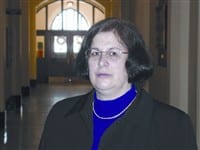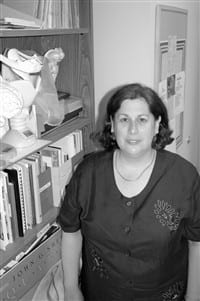Words To Live By
Since children have attended school, teachers have been confronted with language issues — from learning disabilities to pronunciation and stuttering problems.
The only difference these days from decades past is that having speech therapists on staff is not the exception in school districts; it’s the norm. And that means that speech pathologists and other language specialists are in more demand than ever before.
Elms College in Chicopee has taken advantage of that situation, launching a Speech and Language Pathologist Assistant program in 1999 and following that with a CAGS-level (Certificate of Advanced Graduate Study) Communi-cation Sciences and Disorders program in 2001. Both have experienced significant growth since then, although there is room for more, said Kathryn James, director of the programs.
“Because there has been a shortage of speech and language pathologists — and there’s especially a shortage of staff available in the schools to fill the need for these pathologists — this new field has kind of emerged,” James said. “Our programs grew out of the shortage, really.”
Listening for a Need
In deciding to launch its two-year and four-year degree programs in 1999 for speech-language pathology assistants, Elms administrators saw a need brought on by changing demographics.
Much of that involves better medical care. For example, older Americans have a better chance of surviving strokes and are living longer after them, and many of those people need speech therapy. And the number of children surviving premature birth and postnatal illnesses — children who have a greater chance of struggling with language development in the early years — has also increased.
Not only have these developments swelled the cost of health care in general, James said, but training programs have been unable to keep pace with the growing need for speech pathologists and audiologists. As a result, many health workers in schools who do not have specific training in speech-language pathology are performing that duty.
“We’re talking about school-age children, anywhere from K to 12, and a variety of speech, language, and hearing issues,” she said. “There could be learning problems; issues with articulation, pronunciation, and stuttering; there could be problems with swallowing. This field has been around for a long time, but now we’re seeing a shortage.”
To counter these trends, the American Speech-Language Hearing Association has suggested the use of qualified support personnel — pathology assistants — who would require fewer years of education while helping to meet the needs of growing populations with speech and hearing difficulties.
That was the germ of the idea that became the Speech-Language Pathology Assistant track at Elms, James said.
“It is geared to individuals who want to work as speech-language pathology assistants, which doesn’t require a master’s degree,” she said. “So it’s a track or path for individuals who want to begin working after four years of college instead of having to go on to their master’s.”
Because of the growing opportunities in the field, some who work in other fields of education might see an attractive option for career change, she added.
“I could see paraprofessionals — whom we used to call teachers’ aides — wanting to do this. A lot of non-traditional students come back to do the assistant program.”
While the program is a good fit for many students who feel they can’t go beyond a four-year education for financial or other reasons, James said, for those who intend to obtain a graduate-level education, but not right away, it provides an opportunity to start working in the field immediately, after two or four years of undergraduate work.
They can come back later and fill in the required courses to apply to graduate school and return to graduate school at a later time,” she said. “Meanwhile, they’re working as speech assistants. There’s a lot of flexibility built into our program, and that’s a real strength.”
Talk of the Town
Until two years ago, however, students looking for a CAGS-level program in communication and speech disorders had few options in New England. Northeastern University in Boston is currently the closest school that offers such a track, James said.
The post-graduate program at Elms requires six credits of core courses, chosen from among Technological Applications, Bilingual and Multicultural Assessment and Intervention, and Professional Issues and Ethics. Students then choose a concentration in Topics in Child Disorders, Topics in Auditory Disorders, or Sign Language — depending on the type of work they would like to do professionally — and proceed to take 18 credits of courses in that area.
“We’ve built a lot of flexibility into the CAGS program in terms of course selection,” James said. “And students who enroll have six years to complete the certificate, so it gives them quite a bit of time.”
That flexibility is important, considering who the program enrollees are, she added. “The students are master’s-level speech-language pathologists, special educators, school psychologists, and audiologists. That’s the main target audience.”
And because these are working professionals, the courses are offered at times that are convenient for them, James said. “We’re typically going to schedule classes for nights and weekends, or in the summer, so it definitely works around their schedules.”
For many of the students enrolled in the post-graduate program, having to work school around their work lives is worth it in more ways than one, she added.
“It’s a program primarily for speech-language pathologists who are school-based, and in order to keep their licensure, they need to continue their education,” she said. “They don’t have to get a CAGS, but this is a way of formalizing the continuing education they need to get anyway. And for some, it involves a pay increase, so that’s a motivator.”
That motivation is reaping rewards, not only for the students, but for Elms, James said.
“In the past couple of years, it has definitely grown,” she said. “We had very good attendance last summer, and we’ve had consistent interest in it since then. It’s not waning.”
As long as schoolchildren and others need speech therapy — and the statistics say they do, more than ever before — it seems that Elms has found a valuable niche.



Comments are closed.